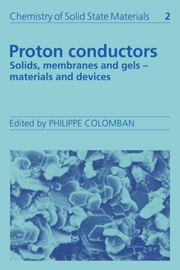Book contents
- Frontmatter
- Contents
- List of contributors
- Preface
- Symbols
- I HYDROGEN BOND AND PROTONIC SPECIES
- II MATERIALS: PREPARATION, STRUCTURES AND PROPERTIES
- III PROTON DYNAMICS AND CHARGE TRANSPORT
- IV PROTON DIFFUSION MECHANISMS
- V DEVICES
- 32 Applications of perfluorinated proton conductors (Nations)
- 33 Synthesis of polycrystalline H3O+ and NH4+ -β″/β-Al2O3 and potential applications in steam-electrolysis/fuel-cells
- 34 Fuel-cells, steam-electrolysis for hydrogen production and hydrogen separation using high temperature protonic conductors
- 35 Ice-based devices
- 36 Solid-state gas sensors operating at room temperature
- 37 All solid-state protonic batteries
- 38 Applicatios of proton conductors in electrochromic devices (ECDs)
- 39 Supercapacitors and interfacial charge accumulation devices
- Index
38 - Applicatios of proton conductors in electrochromic devices (ECDs)
Published online by Cambridge University Press: 04 May 2010
- Frontmatter
- Contents
- List of contributors
- Preface
- Symbols
- I HYDROGEN BOND AND PROTONIC SPECIES
- II MATERIALS: PREPARATION, STRUCTURES AND PROPERTIES
- III PROTON DYNAMICS AND CHARGE TRANSPORT
- IV PROTON DIFFUSION MECHANISMS
- V DEVICES
- 32 Applications of perfluorinated proton conductors (Nations)
- 33 Synthesis of polycrystalline H3O+ and NH4+ -β″/β-Al2O3 and potential applications in steam-electrolysis/fuel-cells
- 34 Fuel-cells, steam-electrolysis for hydrogen production and hydrogen separation using high temperature protonic conductors
- 35 Ice-based devices
- 36 Solid-state gas sensors operating at room temperature
- 37 All solid-state protonic batteries
- 38 Applicatios of proton conductors in electrochromic devices (ECDs)
- 39 Supercapacitors and interfacial charge accumulation devices
- Index
Summary
Introduction
Some mixed conductors, i.e. electronic and ionic, into which ions can be rapidly and reversibly inserted can undergo a colour change. This is, for example, the case of the hydrogen ’bronzes‘, mentioned earlier in this book. The colour change can be either from transparent to coloured or from one colour to another. This phenomenon, which can be produced electrochemically, is called electrochromism. It is broadly defined as the production of an absorption band in a display material caused by an applied electric field or current. Such a property is currently under intensive study because of its potential use for passive information display, glare-free rearview mirrors for automotives, solar control windows or ‘smart’ windows, thermal sensors and projection systems if matrixable.
The electrochromic devices (ECDs) exhibit many attractive features and offer some superior display qualities compared with liquid crystal displays (LCDs) and light emitting diodes (LEDs). The use of ECDs might improve some of the disadvantageous properties of LCDs and LEDs. They typically show a good aesthetic appearance and a good colour contrast especially under high levels of ambient light where emissive displays lose contrast. They have a wide angle of view which is an advantage over most liquid crystal displays. They may exhibit a continuously variable intensity of coloration and possess memory in either the bleached or coloured state without power consumption. They need low driving voltage to operate. Moreover, large area devices can be fabricated as well as all solid-state displays.
- Type
- Chapter
- Information
- Proton ConductorsSolids, Membranes and Gels - Materials and Devices, pp. 551 - 566Publisher: Cambridge University PressPrint publication year: 1992
- 2
- Cited by



